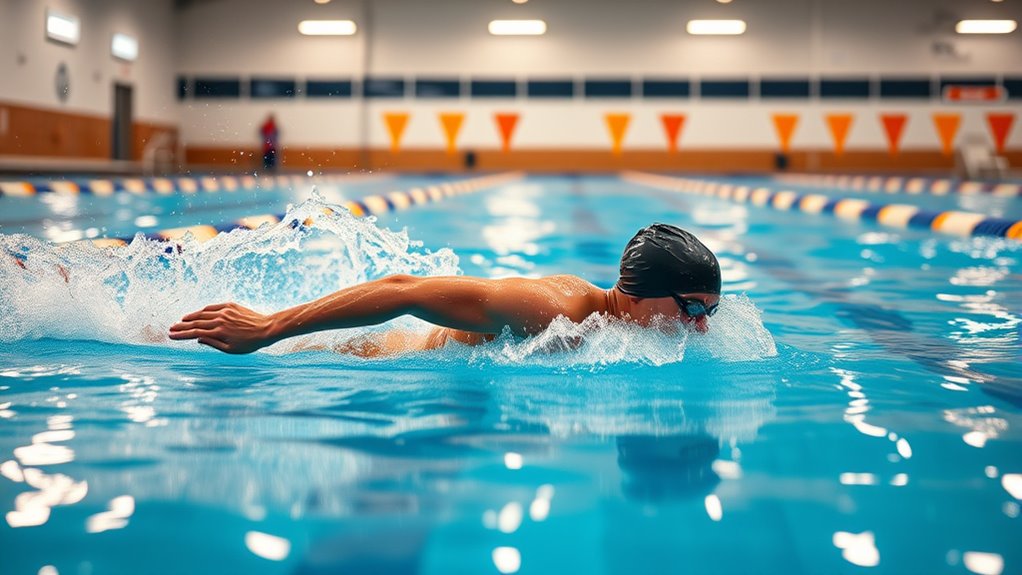To build cardio fast in the pool, try high-intensity interval training by alternating sprints with recovery laps. Use water’s resistance to challenge your muscles and push yourself during sprints, then recover actively to maximize benefits. Focus on maintaining good form, breathing steadily, and increasing intensity gradually. Consistent effort with proper technique accelerates fitness gains effectively. Keep going, and you’ll discover more ways to optimize your pool workouts for rapid cardiovascular improvement.
Key Takeaways
- Incorporate high-intensity sprints with recovery laps to boost cardiovascular fitness quickly.
- Use water resistance actively during each stroke to maximize muscle engagement and endurance.
- Maintain proper breathing techniques, exhaling fully and inhaling rhythmically to sustain effort.
- Structure workouts with warm-up, intervals, and progressive intensity increases for continuous improvement.
- Focus on proper form and gradual progression to prevent injury and optimize cardio-building results.

Have you ever wondered how to boost your swimming fitness quickly and effectively? One of the best ways is through interval training in the pool. This method leverages the water’s natural resistance to challenge your muscles and increase your cardiovascular capacity. As you push through short, intense bursts of swimming, you’ll notice your stamina improves faster than with steady, continuous laps. The key to maximizing these workouts lies in understanding how water resistance and breathing techniques work together to elevate your performance. Water resistance acts as a natural form of strength training, making every stroke more demanding and helping you build muscle endurance. When you swim against the water, you’re not just moving forward—you’re also engaging more muscles, which accelerates your fitness gains. To get the most out of this, focus on maintaining proper form and increasing your pace during high-intensity intervals. This approach guarantees you’re actively fighting against water resistance, rather than just gliding through it. Additionally, incorporating proper training techniques can help optimize your results and prevent injury.
Equally important are your breathing techniques. During intense intervals, your breathing pattern influences your performance and recovery. Practice deep, controlled breaths to make certain your lungs are efficiently exchanging oxygen, which keeps fatigue at bay. Exhale fully underwater during each stroke to maximize oxygen intake and prepare your body for the next burst. As your heart rate climbs during the sprint phases, conscious breathing helps you stay calm and maintain rhythm. It’s tempting to hold your breath or breathe irregularly during exertion, but this can lead to early fatigue and decreased efficiency. Instead, focus on rhythmic breathing—inhale during the glide phase and exhale steadily during your strokes—to sustain your effort over multiple intervals. Over time, these breathing techniques will become second nature, enabling you to push harder and recover quicker during each session.
Incorporating interval training with attention to water resistance and proper breathing opens the way to rapid improvements in your swimming cardio. Start with a warm-up, then alternate between fast, high-intensity sprints and slower recovery laps. For example, swim hard for 30 seconds, then recover for 60 seconds, repeating this cycle several times. As you progress, increase the intensity, duration, or number of intervals to challenge yourself further. Remember, consistency is key—regularly practicing this style of training will help you see noticeable gains in endurance, speed, and overall fitness. With patience and dedication, you’ll find that swimming becomes less about effort and more about pushing your limits with confidence. So, gear up, focus on resistance and breathing, and make interval training your go-to method for building cardio fast.
Frequently Asked Questions
Can Beginners Safely Do Pool Interval Training?
Yes, beginners can safely do pool interval training if you pay attention to water temperature and proper swim stroke techniques. Keep the water warm enough to prevent muscle strains and gradually increase intensity. Focus on mastering basic strokes first, then incorporate intervals slowly. Always listen to your body, take breaks as needed, and consider consulting a trainer to make sure your form is correct and you’re progressing safely.
How Often Should I Do Pool Intervals Weekly?
Think of your weekly pool intervals as tending a garden—you don’t want to overwater or let it wilt. Aim for 2 to 3 sessions, spaced out to allow recovery. Use water resistance to challenge yourself and focus on proper stroke techniques to maximize efficiency. This balance prevents burnout while steadily building your cardio. Consistency, like watering regularly, helps your fitness flourish without overwhelming your body.
What Equipment Is Needed for Pool Interval Workouts?
For pool interval workouts, you mainly need swim gear like goggles, a swim cap, and a kickboard or pull buoy to enhance your training plans. These tools help you focus on specific skills and increase intensity. You don’t need much equipment, making your sessions flexible and effective. Just make certain your gear fits well, and you’re ready to push your cardio in the pool efficiently.
How Can I Prevent Injuries During Pool Training?
Think of your body as a delicate boat steering water. To prevent injuries during pool training, make certain the water temperature isn’t too cold or hot, which can strain muscles. Also, choose a pool with appropriate depth to avoid impact injuries. Warm up thoroughly and listen to your body’s signals. Proper technique and gradual intensity increases help keep you safe, making your workout smooth sailing instead of rough waters.
Are Pool Intervals Effective for Weight Loss?
Yes, pool intervals are effective for weight loss. Water resistance increases the intensity of your workout, helping you burn more calories in less time. By alternating high-intensity efforts with recovery, you boost your calorie burning and improve cardiovascular fitness. Plus, the water’s support reduces joint impact, making it safer and easier to stay consistent. Incorporate pool intervals regularly, and you’ll see better weight loss results while protecting your joints.
Conclusion
Immerse yourself in interval training and watch your cardio soar like a rocket breaking through the water’s surface. As you push through each set, you’re sculpting a heart as strong as steel and lungs as vast as the ocean. Remember, every splash and sprint is a stroke toward a healthier, more powerful you. So, embrace the rhythm, stay motivated, and let your fitness journey flow effortlessly, turning every swim into a wave of unstoppable energy.










